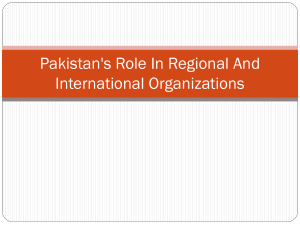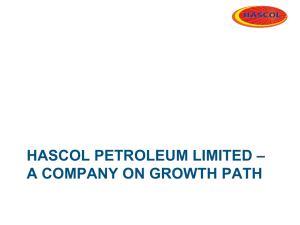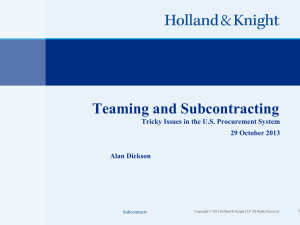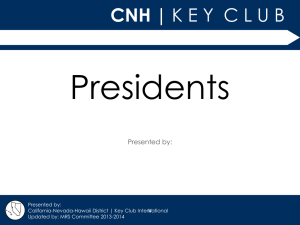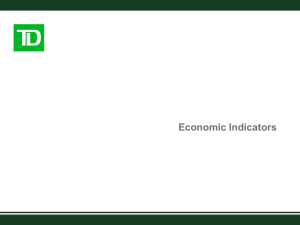Source: State Bank of Pakistan
advertisement
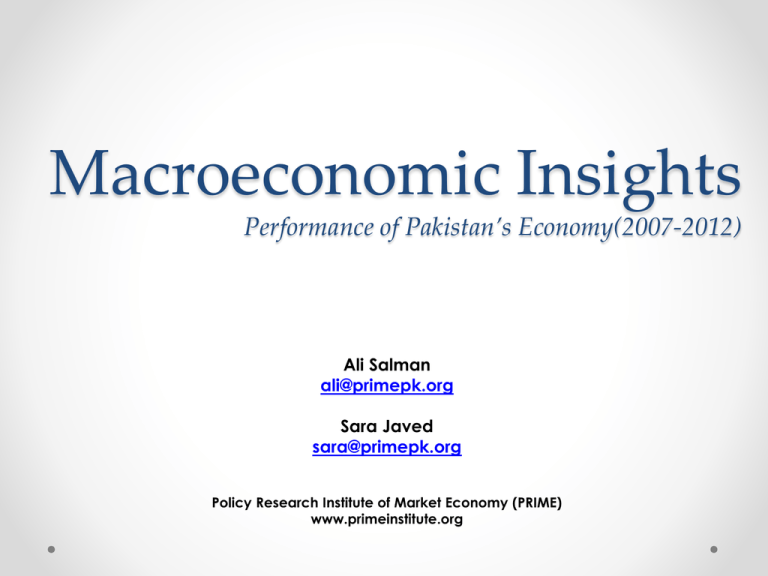
Macroeconomic Insights Performance of Pakistan’s Economy(2007-2012) Ali Salman ali@primepk.org Sara Javed sara@primepk.org Policy Research Institute of Market Economy (PRIME) www.primeinstitute.org Presidents Indicators Chambers Conference Macro Economic 25/02/2013 PRIME Presentation • GDP has increased approximately by 2.37 times in 5 years. • Real Exchange rate was substantially higher than the exchange rate * Right Axis: Exchange Rate Left Axis: GDP Presidents Indicators Chambers Conference Macro Economic Source: State Bank of Pakistan 25/02/2013 PRIME Presentation • Money supply has increased nominally though, it has decreased as a percentage of GDP. • CPI was increasing till 2009, afterward, it has decreased substantially. * Right Axis: Percentage (M2)/ Index (CPI) Left Axis: M2 (Money Supply) Presidents Indicators Chambers Conference Macro Economic Source: State Bank of Pakistan 25/02/2013 PRIME Presentation • Government debt from domestic sources has increased 3 times over the years. • Debt from IMF stood at PKR 2.7 trillion over the last 5 years. Source: State Bank of Pakistan Presidents Indicators Chambers Conference Macro Economic PRIME Presentation Presented by:25/02/2013 Ali Salman (PRIME) • Revenue expenditure has increased by 2 times over the years. • Development expenditure has not increased except slightly for last year. Source: State Bank of Pakistan Macro Economic Indicators Presented by:25/02/2013 PRIME Ali Salman Presentation (PRIME) • Tax revenue has increased by 2.3 times over the last five years. • The distribution of direct and indirect taxes has remained constant. * Right Axis: Tax Revenue and its components Left Axis: Non-tax revenue Presidents Indicators Chambers Conference Macro Economic Source: State Bank of Pakistan Presented by:25/02/2013 PRIME Ali Salman Presentation (PRIME) • The exports over five year have been rising, though it has not helped in improving trade balance. Source: State Bank of Pakistan Presidents Indicators Chambers Conference Macro Economic Presented by:25/02/2013 PRIME Ali Salman Presentation (PRIME) • FDI has decreased by 3 times in 4 years. Source: State Bank of Pakistan Presidents Indicators Chambers Conference Macro Economic Presented by:25/02/2013 PRIME Ali Salman Presentation (PRIME) • The national income has increased by 2.37 times whereas, the national debt has increased by 2.5 times. * Right Axis: Total Domestic Debt Left Axis: GDP Presidents Indicators Chambers Conference Macro Economic Source: State Bank of Pakistan 25/02/2013 PRIME Presentation • Manufacturing Sector has the largest share in private sector advances, constituted 56% of total 2.3 trillion rupees. Advances Manufacturing Electricity, Gas and Water Supply Agriculture, Hunting and Forestry PKR bn. 1,349.30 271.9 199 Commerce and Trade 200.3 Transport, Storage and Communications 110.9 Real Estate, Renting and Business Others Total 104 157.7 2,393.10 Source: State Bank of Pakistan Presidents Indicators Chambers Conference Macro Economic Presented by:25/02/2013 PRIME Ali Salman Presentation (PRIME) • 91% of fiscal deficit of PKR 1.3 trillion is financed through domestic sources, out of which, 44% was contributed by banks. Financing of Fiscal Deficit FY 2011-12 PKR bn, Fiscal Deficit 1,369.70 Financing of fiscal deficit A. External Sources B Domestic Sources 1. Non-bank 529.4 2. Bank 711.1 3. PIBs issues for PSEs debt 391.0 128.7 1,241.10 Source: State Bank of Pakistan, Annual Report 2011-12, page 64 Presidents Indicators Chambers Conference Macro Economic 25/02/2013 PRIME Presentation • Total subsidies of PKR 1.3 trillion has been given to power sector PSEs Total: PKR 1,323.25 bn. Source: Ministry of Finance Presidents Indicators Chambers Conference Macro Economic Presented by:25/02/2013 PRIME Ali Salman Presentation (PRIME) • In last five years, the PSEs accumulated total debt of PKR 2.2 trillion Total: PKR 2,233 bn. 600 Billion Rupees 500 400 300 200 100 0 2007 2008 2009 2010 2011 2012 Total Debt to PSEs Source: State Bank of Pakistan Presidents Indicators Chambers Conference Macro Economic 25/02/2013 PRIME Presentation Pakistan has crossed all threshold of debt entrapment Indicators Threshold Actual values for Pakistan Fiscal Deficit/GDP 3 8 Public debt servicing/ government revenues 15 37 Public domestic debt/government revenues 200 400 Presidents Indicators Chambers Conference Macro Economic 25/02/2013 PRIME Presentation Authors’ Profile Ali Salman Executive Director ali@primepk.org Ali Salman is the founder and Director of Policy Research Institute of Market Economy (PRIME) based in Islamabad. Earlier, he has worked as a consultant and trainer for major international development organizations, public sector organizations and non-profits. Ali is author of several studies and monographs including the “Liberate to Learn: Review of Education Vouchers Scheme in Lahore”, a critique of price controls Price Controls: Implications for Liberty and Welfare, and “Discord between Economic Freedom and Social Justice in Islam.” He has also published a book ‘Alternative Youth Policy in Pakistan.’ Ali regularly writes columns in Express Tribune and a blog on economic issues. Ali Salman has held Fulbright scholarship, Royal Netherlands Fellowship and Charles Wallace fellowship and has master degrees in Economics, Public Policy and Business Administration. He is an adjunct faculty member at Government College University Lahore and is a visiting fellow at Institute of Economic Affairs, London. Ali is an alumnus of International Academy of Leadership, Germany and Atlas Network Think Tank MBA Program. Sara Javed Research Analyst sara@primepk.org Sara is Research Analyst at Policy Research Institute of Market Economy (PRIME) and specializes in trade policy, competition and private sector development. Sara holds masters in Economics & International Economics from University of Nottingham and in Business Administration (Finance & Risk Management) from the Institute of Business Management. She was awarded Globalization and Economic Policy (GEP) scholarship from School of Economics, University of Nottingham where she wrote thesis on Useful Government Spending Under Fixed Exchange Rate: A study on crowding-out effect. She is a regular contributor in economic policy debate through her articles and has attended several national and international conferences and workshops. Besides her work, Sara has interests in paintings, reading and movies. PRIME Presentation

